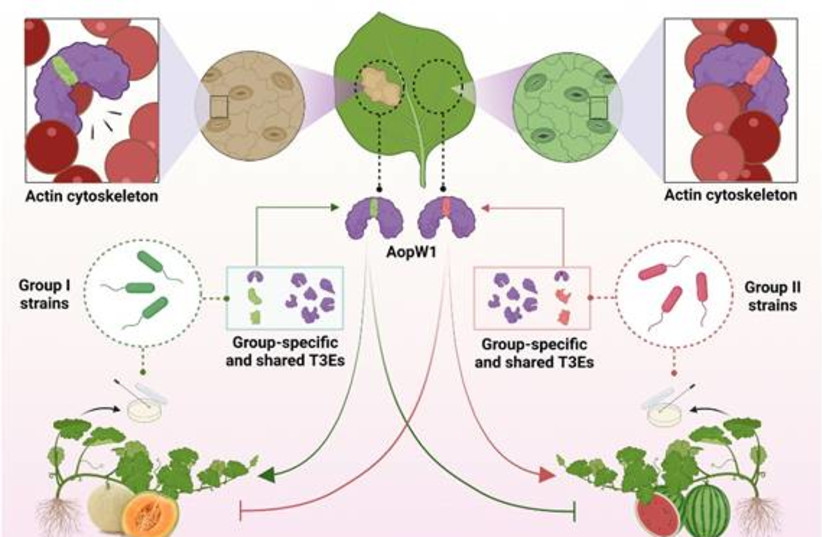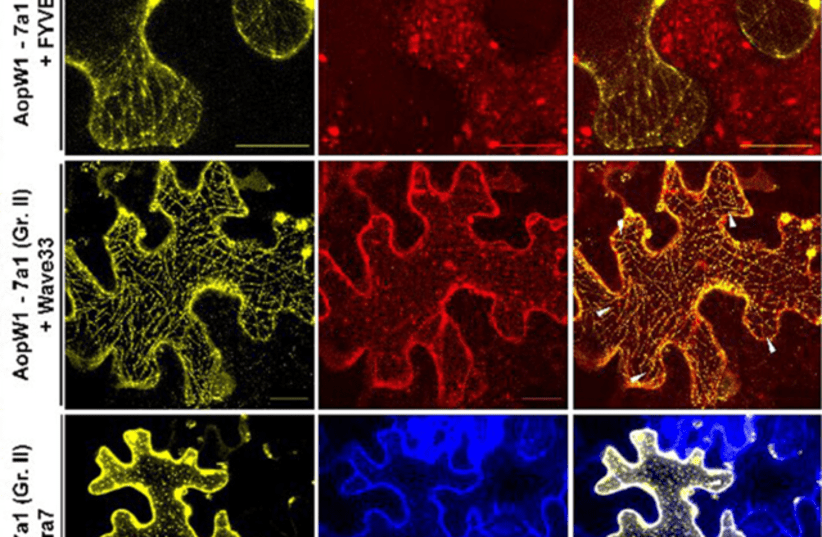Watermelons, cantaloupes, and other melons are among the most popular fruits among Israelis, but these vine-like plants are at risk from bacterial fruit blotch (BFB).
A new study at the Hebrew University of Jerusalem (HU) provides critical insights into the severe disease that affects these crops. The research focuses on the role of the effector AopW1, shedding light on its significance in host adaptation and providing new perspectives on the HopW1 family of bacterial effectors that respond to a stimulus.
Caused by the bacterium Acidovorax citrulli, BFB poses a significant threat to melon and watermelon cultivation. Strains of the pathogen can be classified into two major genetic groups – with group-I strains being strongly associated with melon and group-II strains having higher aggressiveness towards watermelon.
Previous HU research led by Prof. Saul Burdman from the Department of the Plant Pathology and Microbiology department at the Robert Smith Faculty of Agriculture, Food, and Environment discovered that the two groups of strains differ in the arsenal of type-III secreted protein effectors.
They published their findings in The Plant Journal under the title “Natural variation in a short region of the Acidovorax citrulli type III-secreted effector AopW1 is associated with differences in cytotoxicity and host adaptation.”

These effectors are molecules secreted by the bacterium into the host cell, where they manipulate its metabolism to promote disease. On the other hand, certain plant varieties may possess proteins that are able to detect the activity of some of these effectors to promote resistance.
The hypothesis is that differences in the arsenal of effectors are major determinants that shape host preferential association in A. citrulli towards melon or watermelon.
Focus on effectors named AopW1 in the study
The study focused on one of such effectors named AopW1, which has a highly variable region between amino acids 147 to 192. This region differs in 14 amino acids between strains belonging to the two A. citrulli groups. Group I’s AopW1 is more harmful to yeast and Nicotiana benthamiana cells, causing stronger disruption to cell structures, increased cell death, and reduced depositions of protective callose as compared to Group II’s AopW1.
The research team demonstrated the significance of specific amino acid positions within this variable region for AopW1’s harmful effects. AopW1 was also found in different parts of host plant cells, including the endoplasmic reticulum, chloroplasts, and plant endosomes.
The study disclosed a novel aspect of the response to biotic stress by identifying the involvement of the endosome-associated protein EHD1, which, when overexpressed, lessens AopW1-induced cell death and strengthens the plant's defense mechanisms.
Surprisingly, inoculation experiments of melon and watermelon using group-I and -II wild-type and mutant strains showed that AopW1 not only plays a significant role in terms of contribution to virulence of both group-I and -II strains but also contributes to shaping host-preference of group-I and -II strains towards melon and watermelon, respectively.
Excited by the study’s implications, Burdman said: “Our findings provide a deeper understanding of the mechanisms behind bacterial fruit blotch and offer valuable insights into host-pathogen interactions. This knowledge is crucial for developing targeted strategies to mitigate the impact of this threatening disease on melon and watermelon crops. It not only advances our understanding of plant-pathogenic bacteria but also opens new avenues for developing innovative approaches to enhance crop resilience against bacterial fruit blotch.”
